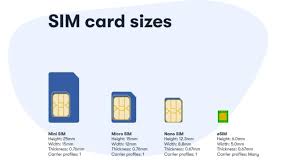

e-SIM.
image ©PCMagA SIM card is a Subscriber Identity Module, and is the way the network identifies the device on the network. It is therefore crucial that a SIM card, or similar, is included in the device for this to be identified on and then use the network. Throughout history the size of the SIM card has changed largely to fit into the shrinking size of mobile phones. These started at credit-card size then along came mini-SIM cards and now the most common size is the nano-SIM. This size is only a milimeter larger than the chip on the card, which is of a standard size, so there is no way to reduce the physical card size any more. Any smaller will also become more difficult to insert into a phone or other device.
Along comes the e-SIM (electronic-SIM). This is a chip that is built into the electronics of the phone. The e-SIM is activated, and changed, via an APP on the phone or via a web site activated by a URL. An e-SIM can contain up to 8 different virtual SIMs, and a user can swap between these SIM accounts whenever they wish. Although a user may swap between operator, they must have or purchase an account on each operator. The e-SIM provides the same functionality as dual SIm phones buy with more choice of options and no need for separate cards.
The main advantage to the user of an e-SIM is that ability to swap SIMS instantly. For example, many people have a work number and a private number, often on different networks. The user can swap between these two networks just as you can on a dual SIM phone. The second advantage is that whilst abroad, the user canbpurchase an account on the foreign network and use their own phone but on the local network thus not accumulating large UK roaming fees. All the time the user will have the same phone with the same data available.
© mobilephonetechnology.co.uk all rights reserved 2017-2025
